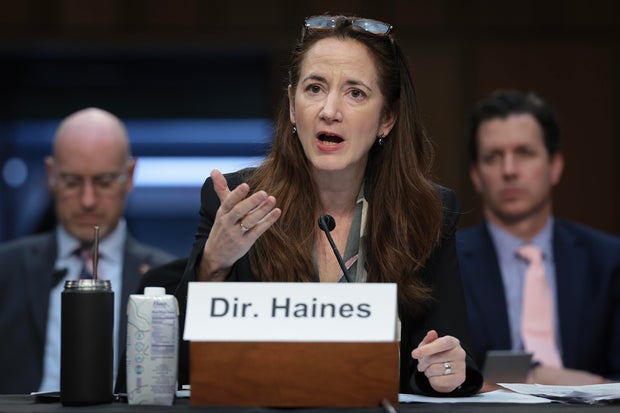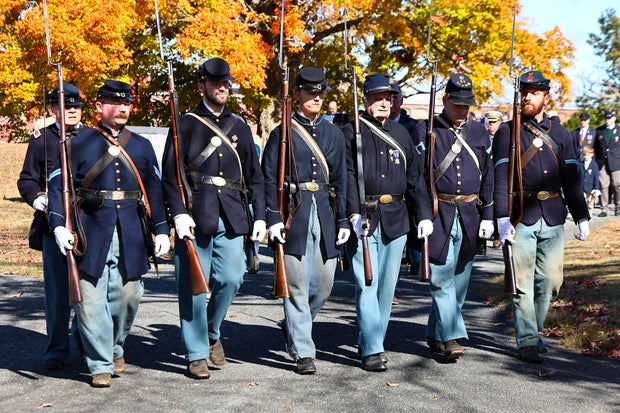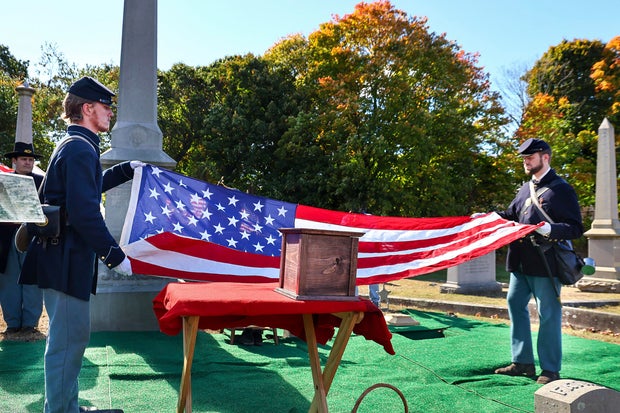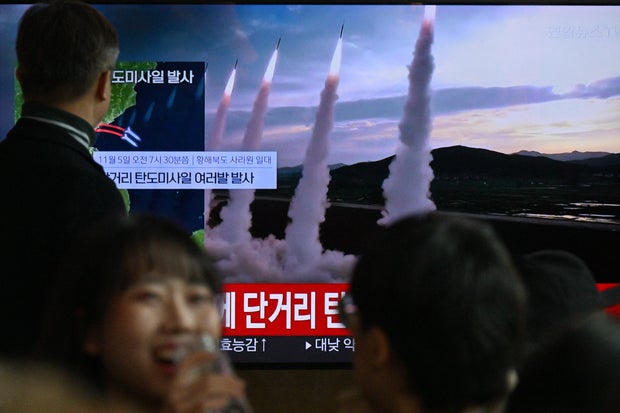CBS News
Generative AI poses threat to election security, federal intelligence agencies warn
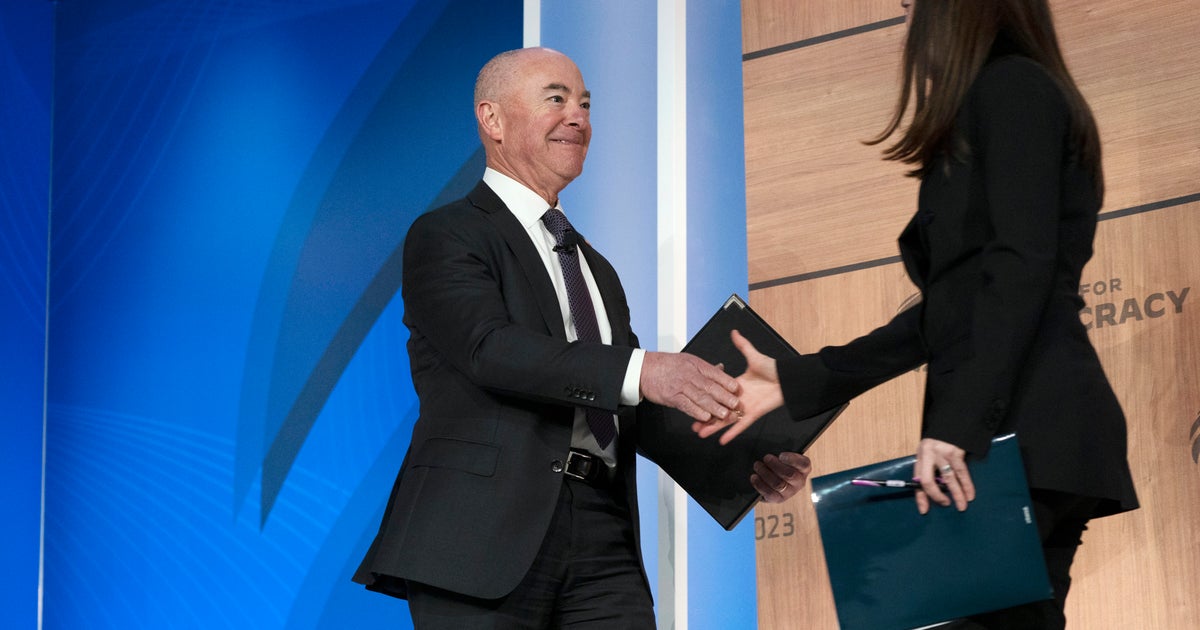
Generative artificial intelligence could threaten election security this November, intelligence agencies warned in a new federal bulletin.
Generative AI uses images, audio, video and code to create new content, like so-called “deep fake” videos in which a person is made to look like they’re saying something they never said.
Both foreign and domestic actors could harness the technology to create serious challenges heading into the 2024 election cycle, according to the analysis compiled by the Department of Homeland Security and sent to law enforcement partners nationwide. Federal bulletins are infrequent messages to law enforcement partners, meant to call attention to specific threats and concerns.
“A variety of threat actors will likely attempt to use generative artificial intelligence (AI) – augmented media to influence and sow discord during the 2024 U.S. election cycle, and AI tools could potentially be used to boost efforts to disrupt the elections,” the bulletin, shared with CBS News, stated. “As the 2024 election cycle progresses, generative AI tools likely provide both domestic and foreign threat actors with enhanced opportunities for interference by aggravating emergent events, disrupting election processes, or attacking election infrastructure.”
Director of National Intelligence Avril Haines also warned Congress about the perils of generative AI during a Senate Intelligence Committee hearing last week, saying AI technology can create realistic “deepfakes” whose origin can be concealed.
“Innovations in AI have enabled foreign influence actors to produce seemingly authentic and tailored messaging more efficiently, at greater scale,” she testified, while insisting the U.S. is better prepared for an election than ever.
Win McNamee/Getty Images
One example the DHS cited in the bulletin was a fake robocall impersonating the voice of President Joe Biden on the eve of the New Hampshire primary in January. The fake audio message was circulated, encouraging recipients of the call to “save your vote” for the November general election instead of participating in the state’s primary.
The “timing of election-specific AI-generated media can be just as critical as the content itself, as it may take time to counter-message or debunk the false content permeating online,” the bulletin said.
The memo also noted the lingering threat overseas, adding that in November 2023, an AI video encouraged a southern Indian state to vote for a specific candidate on election day, giving officials no time to discredit the video.
The bulletin goes on to warn about the potential use of artificial intelligence to target election infrastructure.
“Generative AI could also be leveraged to augment attack plotting if a threat actor, namely a violent extremist, sought to target U.S. election symbols or critical infrastructure,” the bulletin read. “This may include helping to understand U.S. elections and associated infrastructure, scanning internet-facing election infrastructure for potential vulnerabilities, identifying and aggregating a list of election targets or events, and providing new or improved tactical guidance for an attack.”
Some violent extremists have even experimented with AI chatbots to fill gaps in tactical and weapons guidance, DHS said, although the department noted it has not yet observed violent extremists using that technology to supplement election-related target information.
CBS News
Kenyan man convicted of plotting 9/11-style attack on U.S.

A Kenyan man was convicted Monday of plotting a 9/11-style attack on a U.S. building on behalf of the terrorist organization al-Shabab.
A federal jury in Manhattan found Cholo Abdi Abdullah guilty on all six counts he faced for conspiring to hijack an aircraft and slam it into a building, according to court records.
He’s due to be sentenced next March and faces a mandatory minimum of 20 years in prison.
Handout / Criminal Investigation and Detection Group
Abdullah represented himself during the trial, which opened last week. He declined to give an opening statement and did not actively participate in questioning witnesses.
In court papers filed ahead of the trial, prosecutors said Abdullah intended to “merely sit passively during the trial, not oppose the prosecution and whatever the outcome, he would accept the outcome because he does not believe that this is a legitimate system.”
Lawyers appointed to assist Abdullah in his self-defense didn’t respond to an email seeking comment Monday.
Federal prosecutors, who rested their case Thursday, said Abdullah plotted the attack for four years, undergoing extensive training in explosives and how to operate in secret and avoid detection.
He then moved to the Philippines in 2017 and began training as a commercial pilot.
Abdullah was almost finished with his two-year pilot training when he was arrested in 2019 on local charges.
He was transferred the following year to U.S. law enforcement authorities, who charged him with terrorism-related crimes.
Prosecutors said Abdullah also researched how to breach a cockpit door and information “about the tallest building in a major U.S. city” before he was caught.
The State Department in 2008 designated al-Shabab, which means “the youth” in Arabic, as a foreign terrorist organization. The militant group is an al Qaeda affiliate that has fought to establish an Islamic state in Somalia based on Shariah law.
CBS News
The remains of 28 Civil War soldiers were found in a funeral home’s storage. They’ve now been laid to rest.

For several decades, the cremated remains of more than two dozen American Civil War veterans languished in storage facilities at a funeral home and cemetery in Seattle.
The simple copper and cardboard urns gathering dust on shelves only had the name of each of the 28 soldiers – but nothing linking them to the Civil War. Still, that was enough for an organization dedicated to locating, identifying and interring the remains of unclaimed veterans to conclude over several years that they were all Union soldiers deserving of a burial service with military honors.
“It’s amazing that they were still there and we found them,” said Tom Keating, the Washington state coordinator for the Missing In America Project, which turned to a team of volunteers to confirm their war service through genealogical research. “It’s something long overdue. These people have been waiting a long time for a burial.”
Most of the veterans were buried in August at Washington’s Tahoma National Cemetery.
In a traditional service offered to Civil War veterans, the historical 4th U.S. Infantry Regiment dressed in Union uniforms fired musket volleys and the crowd sang “The Battle Hymn of the Republic.” Names were called out for each veteran and their unit before their remains were brought forward and stories were shared about their exploits. Then, they were buried.
Among them was a veteran held at a Confederate prison known as Andersonville. Several were wounded in combat and others fought in critical battles including Gettysburg, Stones River and the Atlanta campaign. One man survived being shot thanks to his pocket watch – which he kept until his death – and another deserted the Confederate Army and joined the Union forces.
“It was something, just the finality of it all,” Keating said, adding they were unable to find any living descendants of the veterans.
While some remains are hidden away in funeral homes, others were found where they fell in battle or by Civil War re-enactors combing old graveyards.
Charles Lawrence / AP
Communities often turn reburials into major events, allowing residents to celebrate veterans and remember a long-forgotten war. In 2016, a volunteer motorcycle group escorted the remains of one veteran cross country from Oregon to the final resting place in Maine. In South Carolina, the remains of 21 Confederate soldiers recovered from forgotten graves beneath the stands of a military college’s football stadium were reburied in 2005.
Sometimes reburials spark controversy. The discovery of the remains of two soldiers from the Manassas National Battlefield in Virginia prompted an unsuccessful attempt in 2018 by several families to have DNA tests done on them. The Army rejected that request and reburied them as unknown soldiers at Arlington National Cemetery.
Along with those buried at Tahoma, Keating said, several others will be buried at Washington State Veterans Cemetery and a Navy veteran will be buried at sea. The remains of several more Civil War veterans were sent to Maine, Rhode Island and other places where family connections were found.
“Would have been lost to history”
Among them was Byron Johnson. Born in Pawtucket in 1844, he enlisted at 18 and served as a hospital steward with the Union Army. He moved out West after the war and died in Seattle in 1913. After his remains were delivered to Pawtucket City Hall, he was buried with military honors at his family’s plot in Oak Grove Cemetery.
Pawtucket Mayor Donald R. Grebien said Johnson’s burial service was the right thing to do.
“When you have somebody who served in a war but especially this war, we want to honor them,” he said. “It became more intriguing when you think this individual was left out there and not buried in his own community.”
Grebien said the burials recall important lessons about the 1861-1865 war to preserve the Union, fought between the North’s Union Army and the Confederate States of America at a cost of hundreds of thousands of lives.
“It was important to remind people not only in Pawtucket but the state of Rhode Island and nationwide that we have people who sacrificed their lives for us and for a lot of the freedoms we have,” he said.
Bruce Frail and his son Ben – both long active in the Sons of Union Veterans of the Civil War – were on hand for service. Ben Frail was also a re-enactor at Johnson’s service, portraying a Union Army captain.
Charles Lawrence / AP
“It’s the best thing we can do for a veteran,” said Bruce Frail, a former commander-in-chief with the Sons of Union Veterans and state coordinator for Missing In America Project.
“The feeling that you get when you honor somebody in that way, it’s indescribable,” he said.
The Missing in America Project says it has identified the remains of over 7,000 veterans and has buried over 6,800 soldiers.
The task of piecing together Johnson’s life story was left to Amelia Boivin, the constituent liaison in the Pawtucket mayor’s office. A history buff, she recalled getting the call requesting the city take possession of his remains and bury them with his family. She got to work and Johnson’s story became the talk of City Hall.
She determined Johnson grew up in Pawtucket, had two sisters and a brother and worked as a druggist after the war. He left to make his fortune out West, first in San Francisco and eventually in Seattle, where he worked nearly up until his death. It doesn’t appear Johnson ever married or had children, and no living relatives were found.
“I felt like it was resolution of sorts,” Boivin said. “It felt like we were doing right for someone who otherwise would have been lost to history.”
Earlier this year, two Union soldiers were posthumously honored by President Biden with the Medal of Honor for their courage in the “Great Locomotive Chase,” in which they went deep behind Confederate lines and stole a train in Marietta, Georgia. They ran the train north, tearing up tracks and cutting telegraph wires as they went.
CBS News
North Korea tests missiles ahead of U.S. election, says American actions warrant its nuclear weapons buildup

Seoul — North Korea fired a salvo of short-range ballistic missiles early Tuesday, Seoul’s military said. It was Pyongyang’s second launch in days and it came just hours before Americans were set to vote for a new president.
The nuclear-armed North last week test-fired what it said was its most advanced and powerful solid-fuel intercontinental ballistic missile (ICBM). That was Kim Jong Un’s first weapons test since he was accused by U.S. and Ukrainian officials of sending soldiers to help support Russia’s ongoing full-scale invasion of Ukraine.
North Korea, which has denied the deployment, is under growing international pressure to withdraw its troops from Russia, with Seoul warning Tuesday that thousands of soldiers were being deployed to front-line areas, including the Russian region of Kursk, which Ukrainian troops pushed into months ago.
Seoul’s Joint Chiefs of Staff said it detected the launch of “several short-range ballistic missiles” at around 7:30 a.m. Tuesday (5:30 p.m. Eastern, Monday) into waters east of the Korean peninsula. The missiles flew approximately 248 miles and Seoul’s military said it had tracked the launch in real time while sharing information with Tokyo and Washington.
ANTHONY WALLACE/AFP/Getty
“In preparation for additional launches, our military has strengthened surveillance and alertness,” it added. Seoul was set to get more U.S. help in monitoring the North’s missile launches, meanwhile, with the State Department in Washington announcing Monday the approval of a new military aid package worth almost $5 billion.
That package includes the potential sale of airborne early warning and control systems to South Korea, with the approval of four E-7 Airborne Early Warning & Control (AEW&C) aircraft, 10 jet engines, and other systems and support elements, at an estimated total cost of $4.92 billion.
The early warning and control aircraft, known as Wedgetails, would enable South Korea to detect missiles and other threats more swiftly and from greater distances than ground-based radar systems.
“This proposed sale will improve the Republic of Korea’s ability to meet current and future threats by providing increased intelligence, surveillance, and reconnaissance (ISR) and airborne early warning and control capabilities,” the State Department said. “It will also increase the ROK Air Force’s command, control, communications, computers, intelligence, surveillance, and reconnaissance (C4ISR) interoperability with the United States.”
On Sunday, South Korea, Japan and the United States conducted a joint air drill involving a U.S. B-1B bomber, South Korean F-15K and KF-16 fighter jets, and Japanese F-2 jets, in response to the ICBM launch. Such joint drills infuriate Pyongyang, which views them as rehearsals for invasion.
U.S. Air Force/South Korea Defense Ministry/AP
Pyongyang called its latest launch “a direct response to the trilateral aerial exercises over the weekend,” Han Kwon-hee of the Korea Association of Defense Industry Studies told AFP. “Given it was a salvo of short-range missiles, the North is indicating that it not only has long-range missiles capable of reaching the U.S., but also short-range ones to target all bases in South Korea and Japan.”
Kim Yo Jong, sister of the country’s leader and a key spokesperson, called the U.S.-South Korea-Japan exercises an “action-based explanation of the most hostile and dangerous aggressive nature of the enemy toward our Republic.”
In a statement carried Tuesday by the official Korean Central News Agency, she said the drill was “absolute proof of the validity and urgency of the line of building up the nuclear forces we have opted for and put into practice.”
Seoul has long accused the nuclear-armed North of sending weapons to help Moscow fight Kyiv and alleged that Pyongyang has moved to deploy soldiers en masse since Kim signed a mutual defense deal with Russian President Vladimir Putin in June.
“More than 10,000 North Korean soldiers are currently in Russia, and we assess that a significant portion of them are deployed to front-line areas, including Kursk,” Jeon Ha-gyu, a spokesman for the South Korean Defense Ministry, said Tuesday.
Seoul, a major weapons exporter, has said it is reviewing whether to send weapons directly to Ukraine in response, something it has previously resisted due to longstanding domestic policy that prevents it from providing weaponry into active conflicts.
With its recent testing spate, “Pyongyang is showing that its contribution of weapons and troops to Russia’s war in Ukraine does not curtail its military activities closer to home,” said Leif-Eric Easley, a professor at Ewha University in Seoul. “On the contrary, cooperation with Moscow appears to enable blatant violations of U.N. Security Council resolutions.”
On Monday, Robert Wood, U.S. deputy ambassador to the U.N., slammed the North’s advancing ballistic missile program and said Russia and China were preventing the U.N. from holding Pyongyang to account.
Beijing and Moscow “have repeatedly shielded the DPRK, contributing to the normalization of these tests and emboldening the DPRK to further violate this Council’s sanctions and resolutions,” he said, referring to the North by its official name.
Speaking Tuesday in Moscow, Russian Deputy Foreign Minister Andrey Rudenko said the North’s missile tests were a justified reaction to U.S. “provocations,” according to Russia’s state-run TASS news agency.


